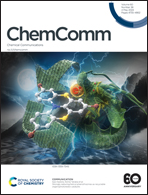Cyano modified triphenylmethyl radical skeletons: higher stability and efficiency†
Abstract
We introduced cyano groups to replace chlorine atoms in the tris(2,4,6-trichlorophenyl)methyl (TTM) radical skeleton, resulting in two cyano-modified TTM skeletons. The incorporation of cyano groups effectively suppresses nonradiative transition processes and lowers the frontier molecular orbital energy levels compared to those of the TTM radical. Consequently, enhanced photoluminescence quantum efficiency (PLQE) and a shift towards longer-wavelength emission in solution were achieved. Furthermore, the cyano-modified TTM skeletons exhibited improved stabilities. The development of these two skeletons adds diversity to stable organic luminescent radical skeletons.



 Please wait while we load your content...
Please wait while we load your content...